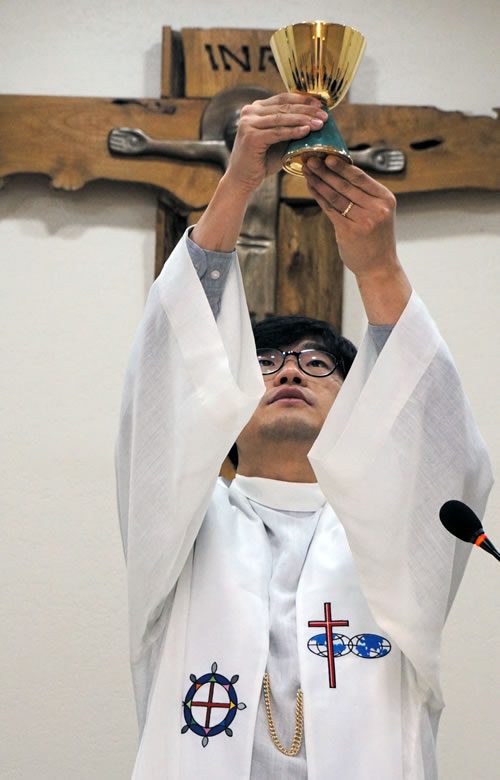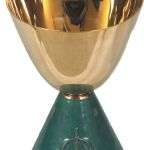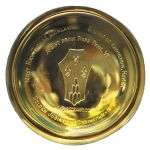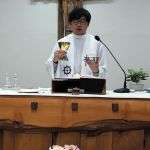
A Source of Courage and Inspiration
On May 9, 2017, newly ordained Columban Fr. Seok Jin-wook Antonio celebrated Mass for the first time at the Columban formation house in Seoul, South Korea. At that Mass he used the chalice which belonged to Bishop Tom Quinlan, one of the Columban pioneers in Korea. The chalice was a gift presented some 50 years ago by Pope Paul VI to Bishop Quinlan on the occasion of his golden jubilee.
Ordained in Ireland in February 1920, Thomas Quinlan was a member of the first group of Columbans assigned to China arriving there in August 1920. His organizational ability was soon recognized, and he was given responsibility for building projects and setting up a school for young students. In 1934 he was appointed to join the first group of Columbans who arrived in Korea in 1933.

Fr. Quinlan immediately put his building experience to use and built a number of parishes and a residence headquarters for the Columbans in Mokpo. When the Columbans opened up a new mission area in the Northern Povince of Kangwon, Fr. Quinlan was one of the two men assigned there. It was a difficult time in Korea with the Japanese occupation where daily surveillance and control was the norm. With Japan joining WWII, the Columbans were either jailed, deported or placed under house arrest. Along with his Irish confreres, Fr. Quinlan was placed under house arrest and detained until the end of the war in 1945.
After their release the Columbans thought the worst was over but within five years the peninsula was engulfed in conflict with the outbreak of the Korean War in June 1950. Fr. Quinlan was arrested yet again in July 1950, this time by North Korean forces. He was one of a group of prisoners that endured the infamous death march. Over a period of nine days, some 700 prisoners were marched 120 miles over snow-capped mountains in sub–zero temperatures. Over 100 died or were shot if they were too weak to walk, and they were buried on the spot. Reflecting on this, Philip Deane, correspondent for the London Observer, who was also a prisoner on that march later wrote "He worked for us, tended our wounds and ailments, gave up his tobacco for others, went out in frost to bury the dead, grew down to a shadow and still he smiled. 'Sure we will be out, Please God' … He was our banner and in a group of remarkably selfless and heroic people – the missionaries of Korea—he was without trying the most remarkable. A saint came to be with us in our hours of trial."
Fr. Quinlan was to spend almost three years in a prison camp in North Korea. After his release in April 1953, he was appointed Papal Delegate to Korea and subsequently bishop of Chuncheon where he worked until his retirement in 1966. The diocese covered the Northern part of Korea which was almost totally devastated in the wake of the war. The energies of the Church were directed towards helping the people recover their lives. Along with rebuilding churches, Bishop Quinlan invited religious congregations to set up clinics and schools in the diocese. In view of his service to the people of the nation, he was awarded Korea's Presidential Medal in 1961. Bishop Quinlan retired in 1966 and spent his final days in the clinic run by the Columban Sisters in Samcheok City on the east coast of Korea.
On the occasion of his Golden Jubilee of ordination in February 1970, Bishop Quinlan was presented with a chalice by Pope Paul VI, and the bishop decided to send it back to the Columban seminary in Ireland. In a letter of October 27, 1970, to his nephew and family, the bishop wrote:
"I enclose a picture of the chalice which our beloved Holy Father graciously deigned to send me on occasion of my Jubilee last February. It is 6 inches high with a large cup for concelebrated Masses. It has a nicely balanced base done in green enamel with the coat of Arms of his Holiness clearly stamped underneath. Lest our northern neighbors ever swoop down and ask me for the loan of it, I sent it to St. Columban's Seminary Navan where it will be a source of courage and inspiration to the students there."
Bishop Quinlan died on the last day of 1970, and he is buried in the cemetery behind the cathedral in Chuncheon. The chalice remained in Navan, Ireland, for 30 years. On the occasion of the Jubilee year in 2000, the Columban Director in Ireland sent it back to Korea. So today, in accordance with the wishes of Bishop Quinlan, it is used at Mass in our formation house in Seoul where young candidates are preparing to be Columban missionaries.
Columban Fr. Donal O'Keefe lives and works in South Korea.


